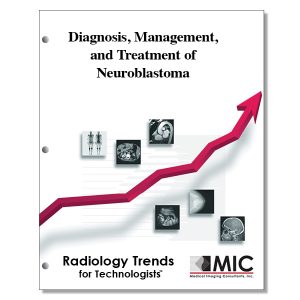

Diagnosis, Management, and Treatment of Neuroblastoma
Updates in the diagnosis, management, and treatment of neuroblastoma are presented including presurgical risk stratification, genetic evaluation of tumors, and the use of advanced imaging modalities.
Course ID: Q00575 Category: Radiology Trends for Technologists Modalities: CT, MRI, Nuclear Medicine, PET, Radiation Therapy2.0 |
Satisfaction Guarantee |
$24.00
- Targeted CE
- Outline
- Objectives
Targeted CE per ARRT’s Discipline, Category, and Subcategory classification for enrollments starting after December 10, 2024:
[Note: Discipline-specific Targeted CE credits may be less than the total Category A credits approved for this course.]
Computed Tomography: 0.25
Procedures: 0.25
Abdomen and Pelvis: 0.25
Magnetic Resonance Imaging: 0.25
Procedures: 0.25
Body: 0.25
Nuclear Medicine Technology: 2.00
Patient Care: 0.25
Patient Interactions and Management: 0.25
Procedures: 1.75
Endocrine and Oncology Procedures: 1.75
Registered Radiologist Assistant: 1.50
Procedures: 1.50
Abdominal Section: 0.25
Thoracic Section: 0.25
Musculoskeletal and Endocrine Sections: 0.25
Neurological, Vascular, and Lymphatic Sections: 0.75
Sonography: 0.25
Procedures: 0.25
Abdomen: 0.25
Radiation Therapy: 1.50
Patient Care: 0.75
Patient and Medical Record Management: 0.75
Procedures: 0.75
Treatment Sites and Tumors: 0.75
Outline
- Introduction
- Epidemiology
- Pathogenesis
- Diagnosis
- Imaging of Neuroblastoma
- Evaluation with US
- CT and MR Imaging
- Nuclear Medicine
- Staging
- Treatment
- Conclusion
Objectives
Upon completion of this course, students will:
- know the locations from which neuroblastomas arise
- be familiar with the timeframe in which neuroblastoma is diagnosed
- understand the possible clinical symptoms of neuroblastoma
- identify the common sites of neuroblastoma metastases
- be familiar with various conditions that can present as a result of a patient’s neuroblastoma
- recognize what is associated with MYCN gene amplification in patients with neuroblastoma
- understand how a neuroblastoma’s DNA index affects the prognosis for patients younger than 18 months of age
- know how neuroblastomas are linked to genetic heritage
- know the basis for neuroblastoma diagnoses
- identify what is necessary to fully evaluate the extent of neuroblastoma
- know why malignant small round cell tumors are sometimes histologically referred to as “blue”
- be familiar with the INPC prognostic classification system for neuroblastoma
- identify what can provide chemical evidence of neuroblastoma when detected in serum and urine levels in elevated quantities
- know the first imaging examination performed when an abdominal mass is suspected in a child
- understand how neuroblastomas affect the surrounding vasculature
- be familiar with some facts and study findings about congenital neuroblastoma
- identify the advantages of CT and MR imaging in the detection and evaluation of neuroblastoma
- know why MR imaging demonstrates a better sensitivity for neuroblastoma evaluation than CT
- be familiar with the strengths, advantages, and isotopes used in MIBG scintigraphy
- understand how the modified Curie scoring method is used in the interpretation of MIBG avidity for patients with high-risk neuroblastoma
- be familiar with the advantages of MIBG scintigraphy over 111In pentetreotide
- know when FDG PET/CT can be a useful diagnostic tool for imaging patients with neuroblastoma
- be familiar with the PET imaging agents and advantages for neuroblastoma imaging
- be familiar with the INRGSS’s image-defined risk factors
- understand the terms used to describe a primary tumor in the INRGSS and which constitutes an IDRF
- recognize the modifications that the INRGSS has made to older INSS for neuroblastoma staging
- be familiar with the descriptions of the various INRGSS stages
- be familiar with the Children’s Oncology Group’s risk stratification system for neuroblastoma
- understand the situations in which surgery, chemotherapy, and radiation therapy should be considered for low, intermediate-, and high-risk neuroblastoma patients
- know the benefits and adverse effects of therapeutic 131I MIBG
